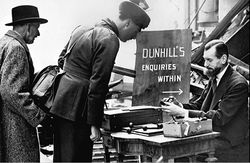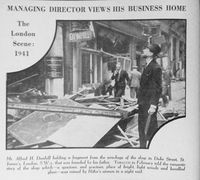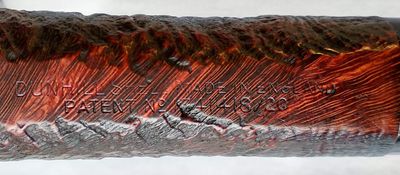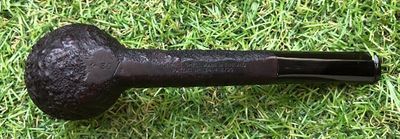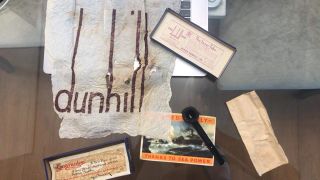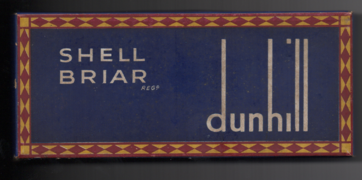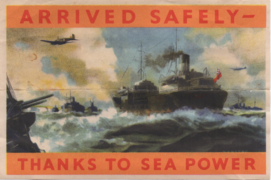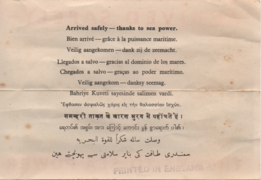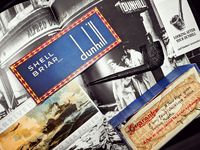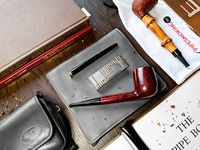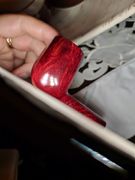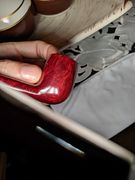WWII Phase: Difference between revisions
No edit summary |
No edit summary |
||
| Line 64: | Line 64: | ||
<br> | <br> | ||
<div class="separator" style="clear: both; text-align: center;"></div> | <div class="separator" style="clear: both; text-align: center;"></div> | ||
<center>'''Addendum'''</center> | |||
---- | |||
<br> | |||
Here we have an atypical example of Bruyere (A) from this period. Remember that Italian Briar for smooth pipes was extremely scarce during the 40s. | |||
[[File:LRM EXPORT 160769927214262 20191006 174701799.jpeg|thumb|right|200px|©Forcióri]] | |||
<blockquote><q>Because a lack of material and paint in the war days, some Dunhill's from that Era look a little strange color wise. Also they could not get enough top quality briar and must do with was available. They used the whole root in war days instead of picking the just best part</q> Fred Wekx.</blockquote> | |||
<gallery mode="packed-hover"> | |||
File:00000IMG_00000_BURST20191005205347757_COVER.jpg | |||
File:00000IMG_00000_BURST20191005205356925_COVER.jpg | |||
File:00000IMG_00000_BURST20191005205440794_COVER.jpg | |||
File:IMG_20191005_210712.jpg | |||
</gallery> | |||
In this particulary case, looks like wood from the center of the burl. | |||
<br> | |||
---- | ---- | ||
[[User:Yang|Yang]] ([[User talk:Yang|talk]]) 09:52, 7 October 2019 (CDT) | [[User:Yang|Yang]] ([[User talk:Yang|talk]]) 09:52, 7 October 2019 (CDT) | ||
[[Category:Pipe makers by nationality]][[Category:Great Britain]] | [[Category:Pipe makers by nationality]][[Category:Great Britain]] | ||
[[Category:Dunhill]] | [[Category:Dunhill]] | ||
Revision as of 00:02, 8 October 2019
In mid-1941, during the infamous Luftwaffe Blitz bombing of London, the Alfred Dunhill store (and many others in the surrounding area) were bombed and almost totally destroyed. The restoration was not fully completed until 1953. A popular piece of lore from that period is that Dunhill employees called Sir. Winston Churchill at 4:00 a.m. to ensure him that his private collection of cigars housed in the store's humidifier had been transferred safely out of danger. As we will see in the following image, Henry Dunhill continued to sell pipes amongst the rubble and ruins of his shop. An example of his remarkable resiliency.
Alfred Henry Dunhill was appointed as president in 1928 by his father, a position he held until 1961. He then decided to leave the company and transfered his presidency to his sister, Mary Dunhill. Alfred Henry Dunhill passed away ten years later (in 1971) at age 75.
In another rare image, courtesy of our friend Jonathan Guss, we have a clipping of a magazine that says:
Mr. Alfred H. Dunhill holding a fragment from the wreckage of the shop in Duke Street, St. Jame's in London, that was founded by his father. Tobacco in February told the romantic story of the shop which "a spacious, and gracious, place of bright, light woods and bevelled glass" was ruined by Hitler's airmen in a night raid.
The Second World War was a difficult time. Rationing due to the war was so drastic that Dunhill suffered from the scarcity of raw material until the beginning of the 1950s, several years into the post-war period.
Dunhill published catalogues annually, even during the First World War with each catalogue being more elegant than the last. There were no catalogues between 1940 and 1950. however, with the exception of two. These were catalogs of "gifts", distributed in North America circa 1943, and in Great Britain at the end of the 1940s.
According to John Loring, few pipes (and mostly uninteresting) were produced by Dunhill during the 1940s. Italian Briar for smooth pipes was extremely scarce, and Algerian Briar (used in sandblasts) was just slightly more available. Likewise, vulcanite for stems was either rationed or forbidden, so that many, if not most of the pipes produced during the war were equipped with horn stems (horn is a very comfortable material, but is easily cracked).
Loring also states that pipes from this period found on the estate market with vulcanite stems likely had the stems replaced at some point. It would not be surprising if Dunhill routinely replaced the horn stems with vulcanite at little or no cost after the war years.
Loring defends a hypothesis in his article called A Hypothetical WWII Pipe, in which he considers that during this period the following nomenclature was used:
No date code or any other nomeclature, like the inner tube, for example. According to the available historiography, the 1341418/20 patent begins to appear in 1920, almost always followed by another patent, as an example: PATENT MARCH.9.15 1341418/20. In rare cases it appeared alone. We recently had access to a pipe bought from that period (unsmoked!), perfectly aligned with Loring's hypothesis. Take special attention to the flyer that states: Arrived Safely - Thanks to Sea Power
and that reminds us of the war.
- WWII Pipe - Shell, Liverpool
Until approximately mid-1936 the nomenclature was done in the possessive, i.e. "Dunhill's Shell". After this period the possessive was dropped, becoming "Dunhill Shell". Thus, as the pieces in question are already from the time of non-possessive nomenclature, we can assume that they are post 1936. The only pieces found with this patent date are from the 1930s (1933 specifically), and return in the beginning of the 1940s (up to 1945, perhaps), when it was replaced by 417574/34. Some pieces have the same patent in the beginning of the 1940s (1941/42), however, with the suffix "U.S.", namely: U.S. PATENT 1341418/20, being destined for the North American market.
Here we have an atypical example of Bruyere (A) from this period. Remember that Italian Briar for smooth pipes was extremely scarce during the 40s.
Because a lack of material and paint in the war days, some Dunhill's from that Era look a little strange color wise. Also they could not get enough top quality briar and must do with was available. They used the whole root in war days instead of picking the just best partFred Wekx.
In this particulary case, looks like wood from the center of the burl.
